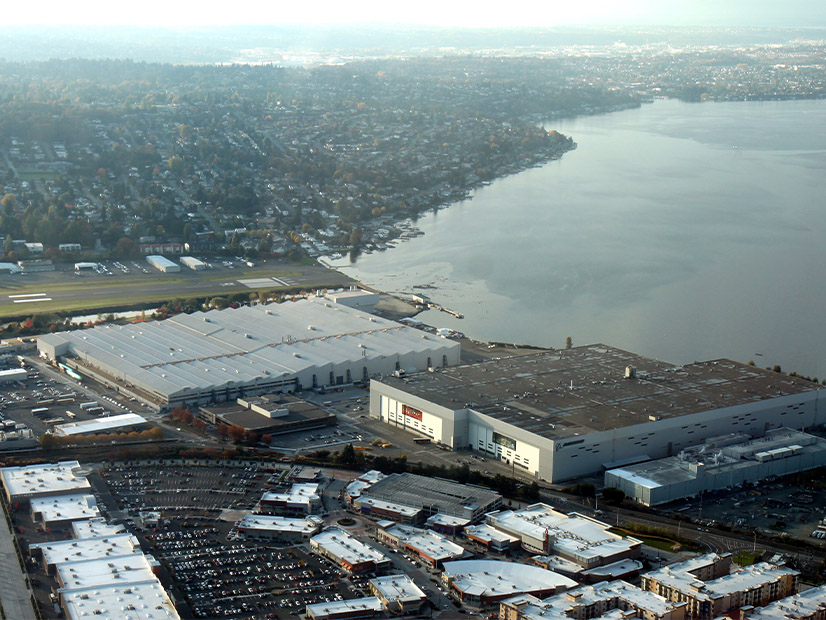
A bill to cushion trade-exposed Washington manufacturers from the economic impact of the state’s cap-and-trade program is getting pushback from the industries the legislation is designed to protect.
Rep. Joe Fitzgibbon (D), chair of the Washington House Environment and Energy Committee, introduced HB 1682 to provide some industries delayed enforcement of the cap-and-trade law passed last year. (See Wash. Becomes 2nd State to Adopt Cap-and-trade.)
Referred to as “energy-intensive, trade-exposed” (EITE), those industries are responsible for roughly 10% of the state’s carbon emissions, Becky Kelley, senior policy adviser for climate to Gov. Jay Inslee, said Tuesday at a hearing on the bill.
EITE industries in Washington include manufacturers in the metals, paper, aerospace, wood products, chemicals, computer and electronics sectors, as well as food processors, cement producers and petroleum refiners.
With passage of the 2021 law, the state government is working this year to implement the nation’s second cap-and-trade system, which is due to begin operating next year. The program would tackle facilities that emit 25,000 metric tons or more of CO2 annually. There are at least 100 such facilities in the state.
A 2021 Washington Department of Ecology report put the state’s CO2 emissions at 99.57 million tons in 2018. A state law calls for overall emissions to be reduced to 50 million tons by 2030, 27 million tons by 2040 and 5 million tons by 2050.
Under cap-and-trade, carbon emitters would have to acquire allowances for specific amounts of carbon pollution, which they can buy, sell or trade with other businesses. The maximum volume of statewide emissions would decrease over time.
Fitzgibbon’s bill would order EITE facilities to provide the state 2015-2019 data on their carbon emissions by September. The Ecology Department would have until November to decide whether to approve a submission as a baseline for a plant. At the start of the program in 2023, each EITE plant would receive a free allowance of permitted emissions equal to the baseline set in 2022. The free allowances would drop to 97% of a plant’s baseline in 2027, to 94% in 2031 and to 88% in 2035. After 2035, the free allowances decline 6% annually from the preceding year.
The bill also would allow a facility to request an increase in its allowances if it can prove it is using the best available pollution-fighting technologies.
“It’s bad for our economy and bad for the environment if we lose the energy-intensive, trade-exposed jobs,” Fitzgibbon said at Tuesday’s hearing. Fitzgibbon added that Inslee wants the legislature to allocate $50 million this session to help EITE industries get started on their carbon-trimming work. Revenue from future sales of carbon emission allowances for non-EITE industries will provide additional money to help the EITE industries, said Luke Martland, the Ecology Department’s Climate Commitment Act implementation manager.
‘Catastrophic Losses’
Pushback came Tuesday from several EITE industry lobbyists, who argued that much of the technology needed to curb emissions does not currently exist.
“The technology to allow us to meet the goals in the later years of the program does not exist. The EITEs should not have their allowances decreased beyond what is technologically possible,” said Patrick Jablonski, environmental manager for the Seattle steel producer Nucor.
Chris McCabe, executive director of the Northwest Pulp & Paper Association, which represents 10 plants, said: “We’re looking at $900 million in compliance costs. It will create significant product shifts out of the state.”
Speaking for the Association of Western Pulp and Paper Workers, Josh Estes added that the bill “doesn’t go far enough to ensure our industries will survive in the state. We will suffer catastrophic losses if the bill passes in its current form.”
“The technology does not exist,” said Brent Downey of Kaiser Aluminum.
Some opponents said their plants depend on natural gas to power their processes; corresponding electric equipment either does not yet exist or is prohibitively expensive to install.
However, oil refiners were split on the bill. The Western States Petroleum Association opposed it, while BP supports it. “It provides certainty for businesses to invest in the future, said BP lobbyist Tom Wolf.
Many opponents said they are willing to work with Fitzgibbon to modify the bill.
Meanwhile, environmental organizations supported the legislation. Clifford Traisman of the Washington Environmental Council said since the bulk of the emissions cuts would come after 2035, the affected industries have time to develop and install new technologies. He called for features to be built into the program to ensure accountability for public spending and to address environmental justice issues.


